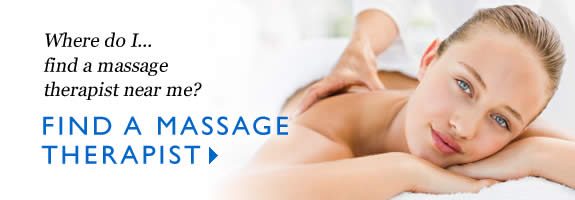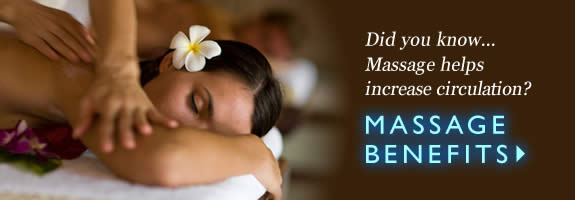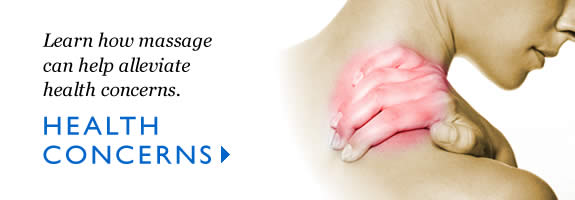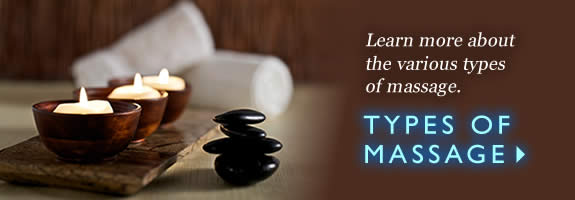Massage FAQs
Here you can search our database of frequently asked questions regarding massage. Topics include techniques, contraindications, benefits, and more.
Questions and Answers
What exactly is a massage? What is a therapeutic massage? What is massage therapy?
Massage, also referred to as therapeutic massage or massage therapy, is defined as the manual manipulation of soft body tissue, such as connective tissue, muscle tissue, tendons and ligaments with the intent being an enhancement of health and well-being. States and organizations that have governing authority over massage therapists all have similar definitions in describing massage therapy.
There are many techniques and modalities in massage therapy, which may address specific conditions or symptoms. For the most part they consist of routines using a combination of stroking, kneading, tapping, friction and/or vibrating to improve muscle tone, restore flexibility of joints, enhance blood and lymph circulation, as well as help with relaxation and stress reduction.
Depending on the modality or technique used, the massage may consist of deep or light pressure and may be stimulating or sedating. Certain modalities such as sports massage use techniques with the intention of enhancing athletic performance or alleviating sports related injuries, while others such as geriatric massage, prenatal massage or infant massage have techniques appropriate for a specific population.
Why should I get a massage? What are the benefits?*
- Massage and other forms of bodywork can help to reduce muscular tension, which results in less pain.
- Massage improves blood and lymph circulation.
- Massage helps to lower blood pressure.
- Massage increases joint flexibility and improves posture.
- Massage helps to reduce anxiety and stress levels and improves concentration.
- Massage promotes quicker healing of injured muscles.
- Massage helps to reduce muscle tightness.
- Massage lessens depression.
- Massage reduces spasms and cramps.
- Massage relieves generalized or chronic pain.
- In some cases, massage reduces or eliminates the need for medication.
- Massage enhances immunity.
- Massage improves quality of sleep.
Are there times when massage is not recommended?
- If you have had recent surgery.
- If you have open sores.
- If you are experiencing acute pain.
- If you have an active inflammation, such as with rheumatoid arthritis.
- If you have an active bacterial or viral infection.
- If you are undergoing chemotherapy or radiation treatments.
- When you are drunk, taking mind-altering drugs or otherwise impaired.
- If you have untreated, high blood pressure.
- If in doubt, check with your primary care physician first.
Where do I go for a massage?*
Your appointment should be made with a licensed or certified massage therapist, educated at a reputable massage school. The massage therapist may have a private office or work with others in a multi-therapist setting such as at a wellness center, spa or salon.
Some massage therapists do make house calls. There may be an additional charge to cover travel time and costs. The massage therapist brings the massage table or floor mat to your home or office and sets up in a comfortable space.
What happens during my first appointment?
The first thing the massage therapist will do is ask you to fill out an intake form. This form will include essentials such as name and contact information. It will also have questions about your general health, medications you are taking, recent surgeries and any ailments or limitations you may have. You may be asked about your activity levels, what type of work you do and your reason for scheduling a massage. Make sure to include all medications as well as herbal and nutritional supplements you are taking, whether prescription or over-the-counter, as their effectiveness can be affected by massage.
It is important to fill out the form as completely as possible. If you have any questions or concerns, discuss them with the massage therapist.
Do I need to get undressed for a massage?
For some types of massage, such as traditional Swedish massage, you need to get undressed. Some people choose to leave on certain articles of clothing such as underwear or socks. For other modalities, such as Shiatsu or chair massage, you remain fully clothed. However, before the massage, the therapist should advise you regarding this matter and instruct you to only disrobe to your own level of comfort.
State regulations require the client to be covered with draping (for those modalities requiring you to undress), usually with a sheet or large towel, except for the body part being treated. So even though you are undressed, you are covered during the massage session.
When do I get undressed? Do I get undressed with the massage therapist in the room?
The massage therapist should bring you into the treatment area and then leave the room, closing the door and allowing you to get undressed in private. Once you are undressed you should get onto the massage table and cover yourself with the towel or sheet provided. If this is your first massage, the therapist should provide you with instructions, such as whether you should lie face down or face up on the table.
What should I expect during the session?
It depends on the type of massage you will receive. The massage therapist should discuss this with you after you fill out the intake form. The massage therapist should ask about your expectations and go over the intake information with you to decide the best form of treatment.
- If you are having a traditional Swedish massage, you will be asked to go into the treatment room, disrobe to your own comfort level, lay on a padded massage table and cover yourself with a sheet or towel. Depending on what your needs are, the massage may include the use of broad, flowing strokes on the arms, hands, legs, feet, back and shoulders. State laws forbid the massaging or touching of genitals or breasts.
- If you are receiving Shiatsu, you may be asked to change into comfortable clothing and lie on a floor mat. The session may consist of gentle, rhythmic pressure along energy line or meridian of the body as well as gentle stretches.
- If you are receiving Thai massage, also called Thai yoga massage, you will most likely be lying on a padded mat, though some Thai practitioners may use a low massage table. The massage therapist will use his or her body, including fingers, fists, elbows, forearms, knees, legs and feet for a combination of acupressure and manipulation of yoga stretches and poses.
- Each form of bodywork may have its own instruction, which should be explained in full by your massage therapist.
- A massage therapist should ask for feedback with regard to your comfort level during the massage.
- A massage should never hurt or produce any bruising.
- A standard full body Swedish massage will generally include your neck, back, shoulders, arms, hands, legs and feet. It may or may not include your face, and unless specifically requested will not include the abdomen. The massage will not include the breast tissue or any genitalia.
- A massage therapist using acupressure techniques will often include abdominal massage as a part of the routine or assessment portion of the session.
What should I wear when I get a massage?
It is important to wear comfortable clothing when you go to get a massage.
- For a Swedish massage you will need to get undressed to the level of your own comfort. This is done with the massage therapist out of the room. He or she will instruct you to cover yourself with the provided sheet or towel for modesty.
- If you are receiving a massage using acupressure techniques, most likely you will be keeping your clothing on. Wear something loose and comfortable, preferably made from natural fabrics like cotton, and that have some give to allow for assisted stretching.
If you are unsure as to what type of clothing to wear for the specific technique your massage therapist will be using, ask before you go to the appointment
How long is a massage session?
A massage session can be as short as 10 or 15 minutes or as long as 90 minutes to two hours depending on the type of massage.
A medical massage, which is usually focused on one area of the body for rehabilitation purposes, may only be 15 minutes, while someone requesting back massage may need a minimum of 30 minutes. Most full-body massage sessions are 60 – 90 minutes long. Depending on the individual policy of the massage therapist, a one-hour appointment may be anywhere from 45 – 60 minutes of actual massage.
Allow at least 15 minutes before and after your appointment to relax, fill out any necessary forms and for undressing/dressing. Being rushed afterwards may reduce some of the positive results of your massage session.
Can I, or should I, talk during a massage session?
There is no need for talking during a massage session. The massage therapist may ask how you are doing, or if the pressure of a certain stroke is too deep or too light. Some clients find that the massage is more relaxing in silence, with the addition of soothing music in the background. Others may find it relaxing to chat a bit during part of the massage. There is no absolute right or wrong in this case. Generally, during the massage, the therapist will not talk except to ask you questions about the treatment or to respond to your questions.
Will I need to do anything during the session?
With the majority of modalities, the client just needs to lie on the massage table or mat. Let the massage therapist do the work he/she is trained to do. If any assistance is needed he/she will let you know. Your job is to relax.
What if I fall asleep during the session?
A massage therapy session is your time to relax. Many people do fall into a gentle sleep while getting a massage and massage therapists are used to this. Your massage therapist will continue with the massage and gently wake you up when the session is over.
Do massage therapists take insurance as payment?
Most massage therapists do not take insurance as payment, because most insurance companies do not cover massage as a benefit. Some insurance companies may provide reimbursement under certain circumstances or if massage is included as some kind of a policy rider.
Will there be any kind of lotion or oil used during the massage session?
Depending on the modality or technique, there may or may not be a lotion or oil used. Modalities like Shiatsu, where the client remains clothed, generally do not use any form of lubricant. With Swedish massage, a lubricant is used to facilitate the gliding motion of the therapist’s hands along the skin. The therapist may ask if you have a preference of oil, crème, lotion or gel. The lubricant may be scented or unscented. Certain essential oils may be added for relaxation or to assist in healing.
Should I tip the massage therapist?
Some massage therapists may have a sign in their office indicating if they do or do not take tips. The general rule is that a tip is not expected if the massage therapist owns the business. If a massage therapist is working for someone else, a tip is acceptable. If you do want to tip, 10% to 15% is appropriate. Massage therapists who practice in a medical setting, similar to physical therapists, do not usually accept tips, while those in a spa setting expect them. In a spa setting a gratuity may be included in the overall bill. Some clients who have regularly scheduled appointments over a long period of time may want to give holiday gifts to their massage therapist, but it should not be expected by the therapist.
How often should I get a massage?
In a perfect world it would be nice to get a massage at least once a week. It is said that Bob Hope had one every day, and he lived to be 100 years old. Many people who schedule regular massages do so every two to four weeks depending on their budget. If the massage sessions are because of a specific condition, such as rehabilitation after a car accident, a physician or chiropractor may prescribe a certain amount of sessions within a given amount of time, such as once a week for 10 weeks.
How much does a massage cost?
The cost of massage varies depending on the location, the length of the massage and the modality used. In New York City a one-hour Swedish massage can range anywhere from $100 and up, while in upstate New York it can range from $60 – $85. In Virginia, the same hour may cost $45 – $85. The massage therapist will usually have a brochure or handout with a listing of the prices.
I'm pregnant. Can I still get a massage?
Massage is great for pregnant women, though there are a few precautions. During the nine months of pregnancy, a woman experiences many changes, both physical and emotional. Massage can help in reducing low back pain, swelling of hands and feet, leg cramps, insomnia, sciatic pain and even sinus congestion. Massage should not be deep or painful, in part because the mother’s body is now producing relaxin, a hormone that helps to loosen joints to prepare for the birth. Your massage therapist may have a special pregnancy table or use bolsters and pillows for your comfort.
Can my newborn baby get a massage?
If you were getting regular massages during your pregnancy, so was your baby. Continuing massage for both you and your child is a good thing and helps strengthen the relationship between mother and child. One of the best things is to receive instruction from your massage therapist on how you can massage your child. Massage helps to release “bonding” hormones. One of these hormones, oxytocin, has long been known to help with the release of mother’s milk and facilitate contractions during labor. New studies have shown that the production of oxytocin has a positive effect on the attachment between mother and child.
I have an old injury that has already healed but is still causing me pain and discomfort. Can massage help?
While massage is most efficient at the reduction of scars and improvement of joint flexibility when given in the early stages of injury rehabilitation, it can also be of tremendous help even after a considerable amount of time has passed. Old traumas, whether physical or psychological, can remain in the body long after the actual event or injury and cause a great deal of discomfort and pain in muscles, tendons, ligaments and joints. Massage can be helpful in reducing and eventually eliminating much of that discomfort by relaxing muscles and improving joint flexibility. Massage also helps to release “feel good” hormones in the body such as oxytocin and endorphins, which act as natural analgesics (pain killers). It also helps to improve the function of neurotransmitters, which help to regulate the communication between neurons and other cells in the body.
My trauma is not physical, but more of a psychological nature (such as Post Traumatic Stress Disorder). Can massage help?
Massage helps not only with physical pain, but psychological pain as well. Massage and healthy, positive touch helps to restore trust. And, because psychological trauma can be stored within the body, both within the nervous system and in connective tissue, the use of massage helps to release the stress and tension caused by trauma and restore normalcy to the mind and body. While you cannot expect massage to be the cure-all in such cases, it has been shown to be very effective in facilitating recovery when used in conjunction with psychologists and other mental health professionals experienced in this area.
What if I start to cry during my massage?
Because massage has an effect on the parasympathetic (or rest and relax) mechanisms in the body, a person may have various unanticipated emotional or physical reactions during a massage – including crying. This may or may not be due to an emotional release, or to the release of tension within muscle tissue. Tension in the body may also find its release through unexpected laughter in some people. Your massage therapist is trained to be prepared for all kinds of situations. If you are feeling upset during the session you have the right to ask the massage therapist to stop the massage.
What is the difference between a Swedish massage and acupressure?
Both Swedish massage and acupressure are considered forms of massage by most governing authorities. With Swedish massage the client lies on a padded table, is undressed, but modestly draped for the session. The session will usually consist of long and short gliding strokes, percussive movements and/or kneading on the back, shoulders and neck as well as the arms and legs. Oil, crème or lotion is used to facilitate the glide. In some variations of Swedish massage passive stretches may be used as well.
Does massage hurt?
With the majority of modalities and techniques, massage should not hurt, nor should it cause bruising. Certain styles of massage, such as Rolfing or deep tissue massage have a reputation for being painful, but these techniques are the exceptions. You may already have sore or tender areas on your body, and when touched they may hurt. But massage should not be the originating cause of pain.
I got my first massage and I feel worse – not better. Is that normal?
Usually, massage will make you feel better. It will relax you as well as invigorate you. Occasionally, if your muscles are very tight or if you are on the verge of getting sick with a cold or flu, you may feel worse before you feel better. Your body is reacting to what the massage has done which is to release stored up toxins, activate underused muscles, relax overused ones, stimulate your blood and lymph systems and give your body a bit of a workout. If you are someone who doesn’t exercise much, eats a lot of junk food, smokes, is very sedentary in general or is exposed to toxic material on a regular basis, the massage will activate the systems in your body that facilitate the removal of harmful substances. Getting a massage once, or on an irregular basis, may cause you some discomfort for a day or two afterward. This is caused in part by the toxins being processed and eliminated by your body. Getting a massage on a regular basis, as well as reducing your exposure to toxins, improving your diet and participating in exercise will eventually reduce and even eliminate this discomfort.
I’ve been avoiding getting a massage because I’m ticklish. What can I do?
Even people who are ticklish can get a massage. The first thing is to tell your massage therapist before the session begins. Massage therapists are trained to deal with various sensitivities such as ticklishness.
Why does massage make me feel so good?
Ask people who get a massage on a regular basis and they will most likely tell you that they can’t imagine life without it. For some it becomes a positive kind of addiction. Touch is a very important need for the human body, and in today’s society we are very under touched. We are busy working every day, at our computers, in our cars and sitting in front of our television sets. This all leads to touch deprivation. Studies have shown that babies can die from lack of touch. Without touch they refuse to eat.



